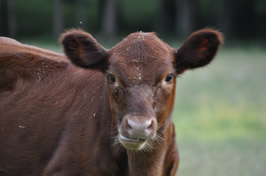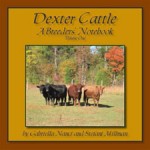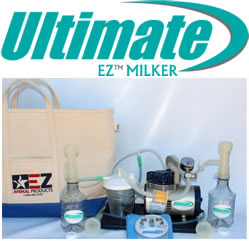WHAT A DEXTER SHOULD BE (Author: Stefani Millman June 2009. Watch for our Illustrated Breed Description in Dexter Cattle, A Breeders’ Notebook, Volume II)
A dual-purpose animal is bred to serve two functions: milk and beef. The Dexter is to be compactly built, shorter in length than that of a true dairy breed but thicker in the thighs, hips, loin, and shoulders. Its disposition should be easy to handle and docile as its main purpose is to be a family cow. It should not be overly large and tall, nor should it be excessively small.
OVERALL DESCRIPTION
Balance: The size of bone, depth and fullness of all parts, low-setness, and shortness of leg and neck should reveal a consistently uniform harmony throughout. A balanced animal reveals equality in all parts. The animal should appear smoothly blended in such proportions as to give even and uniform appearance.
Quality: Indicated by smooth, neat, clean-cut features throughout which contribute to the beauty and general ability of the animal to economically perform the function of production. Neat joints, general refined condition of bone, a pliable softness to the hair and hide, a clean-cut appearance of the head and smoothness of body lines and finish are necessary attributes.
Style: Associated with harmonious development in all body characteristics. It involves the general beauty and the degree of grace, which it displays while moving or at rest. Attractive, graceful carriage and the animal should have enough nervous response versus stability to keep muscles in proper tone and holding the body together to impress his or her true value. Style is often responsible for an animal catching the eye of a judge or prospective buyer and selling at a premium.
Constitution: Characteristics that determine the feeding ability, reproductive capacity, health, vigor and longevity: Broad mouth and large nostrils; wide and deep chest capacity, as determined by the length and fullness of the fore ribs and width of chest floor; deep heart girth and well-sprung ribs encase the diaphragm, heart and lungs, which are vital to longevity and reproductive ability.
BODY PARTS
Head: Medium in length, clean-cut, and tapering down into a broad muzzle that is strong and powerful with wide, open nostrils; lean, strong jaw with teeth matching pad correctly, as to avoid and under or over bite. Eyes: Full, bright and lively, large and alert. Forehead: Wide between the eyes, bridge of nose straight. Ears: Relative to size of head, neatly placed and alertly carried. A desirable head displays breed character, refinement, without frailty, desirable proportions, strength with good muscling of the lower jaw, combined with alertness and interest in the surroundings.
Neck: Blends smoothly into shoulders and brisket. Clean throat and dewlap without excessive flesh or surplus skin underneath.
Shoulders: Set smoothly against chest wall and withers with an adequate cover of flesh. Winged shoulder is the term used to describe the condition caused by the failure of the connective tissues to hold the shoulder blade firmly to the rib structure. The point of the shoulder will be pulled away from the ribs. Winged shoulder is undesirable.
Brisket and Chest: Deep and wide between he front legs, neat and trim with little dewlap.
Withers: Sharpness of withers and thickness at the top of the shoulders coincides with condition. A cow in heavy flow of milk and relatively thin flesh will usually be sharp at the withers, whereas the same cow in high condition just prior to calving may show a thickness of 5 – 6 inches (or possibly more) at this region.
Ribs: Barrel deep and strongly supported with ribs wide apart, well sprung, and covered with firm flesh. Little space between the ribs and hips. Depth and width tending to increase toward rear of barrel. Heart Girth: Large and deep, filled both out and down; contributing its part in a straight bottom line and side line. Foreribs: Should be long and well sprung with a wide chest floor between front legs and fullness at the point of elbow.
Back: The topline should be strong and straight from withers to end of tail head with adequate flesh. The topline is determined by the position and strength of the backbone (vertebral column). Much of the roughness or lack of symmetry and smoothness in and animal is due to the irregularity of the spinal column. This roughness may or may not impair the function of the animal, but it does reduce eye appeal and thus reduces the value of registered, purebred animals.
Loin: Broad, deep, thick, strong, smoothly fleshed nearly at maturity. A young animal may roach (curve upward) at the loin but will level out at maturity. This is only permissible at the loin; if the back roaches midway, the prospect for improvement is not favorable.
Hips: Wide, approximately level laterally with the back, with adequate flesh. Females will tend to be more prominent in the hips than males.
Pin Bones: Wide apart and slightly lower than hip; contributing to calving ease.
Rump: Long and wide, it should carry out the same width that prevails in the loin and ribs. Straight, level from the loin and square at the tail head. Pelvic bone shape, slope from hook to pin, and the distance between hook to pin all contribute to rump formation. Sloping, droopy or narrow are not ideal. A high tail head detracts from the overall appearance of the rump.
Flank: Deep and smooth, allowing for capacity.
Thigh: Wide apart when viewed from the rear, providing sufficient room for udder and its attachments. Its fullness should carry well down to the hock.
Legs: Legs straight, set in all four corners of the animal, wide apart; clean-cut and strong. Toes pointed forward. Bones of the legs must be firm and dense, pasterns relatively straight, of medium length, strong and springy. Hocks cleanly molded with an adequate amount of bend. Feet short, balanced, well rounded with deep heel and level sole. Hind legs nearly perpendicular from hock to pastern. When viewed from behind, legs set wide apart and straight. Tendons well defined. Poor bone quality, puffy joints, weak pasterns, and long toes with under-slung heels are extremely undesirable.
Udder: Long along the underline, wide, and of moderate depth with a smooth floor. Full and balanced in all four corners of even symmetry. Extending well forward and strongly attached. Rear attachment high and wide. Teats placed squarely and evenly in all four corners and are uniform and a convenient size. Cylindrical in shape, free from obstructions, well apart and plumb. Texture soft pliable and elastic. Well collapsed after milking. May not show excessive veination on either or both udder and body.
Scrotum and Sheath: Testicles balanced and symmetrical. Rudimentary teats set wide apart, squarely placed in front of scrotum. Sheath: Clean cut to belly without sagging skin.
Tail: Fine, hanging straight. Tail head level and set neatly between pin bones.
Color: Black, red or dun. White is permissible if confined to the rear part of the underline behind the navel. It is often found on the udder or in the tail switch. White on the scrotum, or forward of the navel is unfavorable. Black has a black or “smutty” nose, teats and hoof color. Red has various shades of pink nose and teats, or a black “smutty” nose, hooves are brown or black. Dun has a tan colored nose and teats and brown hooves. Teats may be pink on a white udder. Both red and dun coat colors range in several shades.
Size: Frame score should be one (1) or below for both males and females. Cattle must be of diminutive stature compared to that of a standard breed but still capable of producing a carcass of reasonable market value, and a reasonable quantity and quality of milk production. They should be of their proper size for sex and age. They should have proper form and equivalent body proportions.
Horns: Inclining up and forwards on females, more forward on males, moderately small at base, medium in length, tapering towards black tips, or brown in the case of red and dun animals. They should contribute to the attractiveness of the head by being neat, symmetrical and properly placed. Dehorned animals are allowed without penalty.
Polled: Polled animals are characterized by a well-defined poll.


